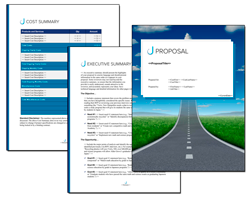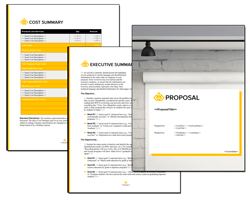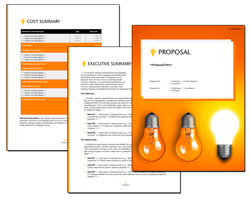
How to Write an Internal Company Proposal: Tips & Examples
Do you need help to write an internal company proposal? This guide simplifies the process, offering clear steps to help you create a proposal that can significantly influence decision-makers by clearly outlining the project's benefits, structure, and expected outcomes. Follow along to ensure your ideas get the attention they deserve.
Key Takeaways
- Create an internal proposal as a document that aligns with company goals, presenting a clear problem and a solution.
- Use a well-structured format with key sections, such as an engaging executive summary and a detailed project plan, to enhance clarity and persuasion.
- Avoid common pitfalls by customizing each proposal, emphasizing value over price, and proactively addressing potential risks and objections.
Understanding Internal Company Proposals

An internal company proposal is a document created to pitch a project or idea to company management. It could launch a new product line, solve a prevailing issue, or introduce an innovative process. The true power of a well-written proposal lies in its ability to motivate significant organizational changes and actions.
Imagine your proposal as a blueprint that guides your company's decision-makers through your vision. A proposal must be clear, concise, and compelling enough to justify allocating resources and support. A well-written proposal can significantly influence decision-makers by clearly outlining the project's benefits, structure, and expected outcomes.
Internal project proposals are about more than presenting an idea; they are about creating a persuasive case that aligns with the company's goals and resonates with its stakeholders.
The structure of an internal company proposal, such as the chapter topics used and flow, is the same as that of any other project pitch proposal. It's the audience that is different. You will be making a persuasive argument to company executives rather than a customer.
Key Elements of Effective Internal Project Proposals
Creating a successful business proposal involves several key elements. At the heart of any project proposal is a clear overview that provides a snapshot of what's being proposed. This includes the objectives and the problems and how your proposal aims to address them with a unique solution. An effective proposal can influence decision-makers by clearly outlining the project's benefits, structure, and expected outcomes.
Effective business proposals are tailored to meet the company's needs and demands. This means highlighting the problem to demonstrate its impact and justifying the need for a solution. Additionally, defining the value proposition helps outline the benefits and anticipated outcomes, ensuring stakeholders see the direct value of business success.
Another crucial aspect of a well-written proposal is the inclusion of clear and measurable project objectives. This helps set expectations and define success. Furthermore, presenting credentials, recommendations, and a solid call to action at the end of the proposal can significantly reinforce the value proposition.
Differentiating your value proposition is crucial for an effective business proposal. Additionally, addressing key selling points, managing expectations, and involving stakeholders during the development process are also important. Addressing company needs while presenting a clear and compelling case enhances your chances of gaining support and approval.
Preparing Your Proposal

Preparation is key to creating a winning project proposal. Start by thoroughly understanding your business's objectives and the company's needs. This involves tailoring your proposal writing to meet their specific expectations and demands.
Outlining the project's importance and goals effectively communicates its significance. Collect all critical information, including company needs, timelines, and decision-making criteria. This ensures your proposal is well-informed and aligned with the stakeholders' priorities.
A grasp of your organization's decision-making process, including key stakeholders and their criteria, can significantly boost your proposal's effectiveness. Additionally, obtaining a verbal agreement before writing the proposal can help avoid misunderstandings and set clear expectations.
Understanding the company's needs is vital for creating a successful proposal. This involves in-depth research and planning to ensure your proposal resonates with the management and addresses their specific challenges and goals.
Structuring Your Internal Company Proposal
A well-structured proposal is important for engaging your audience and ensuring your message is clear and compelling. Start with an introduction that outlines the project's objectives and significance. Follow this with a table of contents, an executive summary, and detailed sections covering every proposal aspect.
Each section of the proposal should be organized to provide a logical flow of information. This structure makes the proposal more straightforward to read and demonstrates thorough research and planning, which can reassure stakeholders of the project's viability.
Title Page
The title page is your first impression and sets the expectations for the reader. It should include basic information such as the company name, project title, executive summary, project timeframe, preparer details, attached documents, and table of contents.
An effective title page introduces the project succinctly and prepares the reader for the following detailed content.
Executive Summary

The executive summary provides a quick overview of the entire proposal. It is vital to make this section concise and highly structured, as it may be the only section read by upper management. Capture their attention by clearly conveying the key project points and expected outcomes.
Engaging higher-level decision-makers through an executive summary increases the likelihood of proposal approval. Focusing on important information and making a case sets the stage for the following sections.
Problem Statement
A well-defined problem statement is crucial for highlighting the issue's significance. Clearly articulate the problem, its impact, and why it necessitates a solution. This sets the stage for the proposed solution by demonstrating the immediate need for action.
A solid foundation with a clear problem statement prepares the reader to understand and appreciate the proposed solution.
Proposed Solution

The proposed solution section should describe how your project will address the identified problem in detail. To demonstrate the effectiveness of your solution, include supporting evidence such as case studies, success stories, and testimonials.
Clearly state how the proposed solution will benefit the organization and solve the problem. This section should be compelling enough to convince stakeholders of the viability and value of your proposal.
Project Plan
The project plan outlines the business plan, scope of work, timelines, and responsibilities. It also details the project execution steps, including who will be responsible for each task, the location, duration, and cost.
Presenting a clear deliverables slide aligns expectations and helps justify pricing. This section should provide a comprehensive view of the project's execution and management.
Budget and Resources
Including a detailed budget is important to outline the pricing and scope of your proposed services. A comprehensive budget proposal should include basic project information, detailed costs, a line-item budget, a budget narrative, competing quotes, and additional financial statements.
Presenting the project's budget helps manage executives' expectations and reduces frustration over unexpected costs or missing deliverables.
Conclusion

Summarize the proposal's main points, highlighting the expected outcomes, benefits, and ROI. Include a solid call to action to prompt immediate decision-making.
This final section should leave a lasting impression and motivate stakeholders to support your project.
Using Proposal Kit Templates
Pre-designed templates can streamline the proposal writing process and ensure all necessary elements are included. Proposal Kit's templates and software are designed for internal company proposals, providing layouts, samples, and tools to simplify the process, including many pre-made layouts.
Since most proposals are written for unique situations, there is typically no one-size-fits-all pre-made template that will cover most situations. This is why Proposal Kit's template and software solutions are designed for building custom templates based on pre-made layouts as customizable starting points, with a library of thousands of chapter topics to choose from.
Building a custom template with Proposal Kit can significantly reduce the time needed to create new proposals. Leveraging these tools enhances the quality and efficiency of your proposal writing.
Here are some related samples included in every downloadable Proposal Pack
The AI Writer generates a first draft of these templates - customized to your company, client, and project - in just minutes, giving you a head start on editing. Get any Proposal Pack or Proposal Kit Professional, and all of these samples, and the AI Writer are included.
- Commercial Office Real Estate Lease Proposal
- Process Improvement Sample Proposal
- Job Share Position Sample Proposal
- Manufacturing Process Improvement Sample Proposal
- Feasibility Study Sample
- Electronic Medical Record System Sample Proposal
- Patenting New Technology Sample Proposal
- New Sales Office Sample Proposal
- Ranching Supply Sample Proposal
Here are some related downloadable templates
The AI Writer generates a first draft of these templates - customized to your company, client, and project - in just minutes, giving you a head start on editing. Get any Proposal Pack or Proposal Kit Professional, and all of these templates and the AI Writer are included.
- Artwork Purchasing Proposal
- Asset Tracking and Management Project Proposal
- BANT Sales Proposal Template
- Business Case Document
- Business Continuity During Labor Shortages Proposal Template
- Business Continuity Services Proposal
- Business Management Proposal
- Business Model Change Planning Rolling Shutdowns Proposal
- Business Strategy Change and Implementation Proposal
- Community Impact Mitigation Proposal Template
- Corporate Restructuring Proposal
- Customer Service Improvement Proposal
- Downsizing Company Cost Savings Proposal
- Due Diligence Project Proposal
- Ecommerce Proposal Template
- Emergency Preparation Project Proposal
- Equipment or Machinery Systems Upgrade Proposal
- In-House Lab to Save Costs and Protect Trade Secrets Proposal
- Industrial Design Project Proposal
- Intelligent Factory Reshoring RFP Template
- Inventory Management Project Proposal
- Inventory Management Proposal Template
- Labor Cost Management Proposal Template
- Management Consulting Proposal Template
- Modeling and Simulation Proposal Template
- New Office Location Business Plan
- New Office Space Purchase and Relocation Proposal
- New Sales Office Proposal
- Organizational Development Proposal
- Organizational and Managerial Structure Report
- Outsource Supply Production Locally Proposal
- Outsourcing Customer Support Proposal
- Outsourcing a Department Proposal
- Pilot Project Proposal
- Process Improvement Proposal
- Product Cost Savings Sales Proposal
- Product Manufacturing Moving Overseas Proposal
- Prototyping and Product Design Proposal
- Purchasing Tablet Computers for Field Use Proposal
- Quality Assurance Project Proposal
- Readiness Assessment Project Proposal
- Relocate Manufacturing Domestic Proposal
- Sales Quota Improvement Proposal
- Business Complaint And Solution Proposal Template
- FinTech Cost Benefit Analysis Proposal Template
- Management Proposal Template
- Inventory Proposal Template
Tips for Writing a Winning Internal Company Proposal
Writing a winning project proposal involves more than just presenting an idea; it requires an approach. Ensure your proposal aligns with company goals and outlines the benefits that justify the project's support from management. Emphasize the value offered rather than just the price.
Acknowledging potential risks and presenting mitigation strategies is crucial for building stakeholder trust. Introduce the proposal team to foster a sense of connection and reduce the focus on price. Proofreading the proposal is important for error-free communication of ideas and building credibility.
Tailor each proposal to the specific audience to demonstrate a deeper understanding of their needs. Avoid common pitfalls such as overusing technical jargon, failing to proofread, and reusing content without customization.
Common Mistakes to Avoid

One of the most common mistakes in proposal writing is including fluff and redundant content, which can decrease the proposal's effectiveness. Ensure clarity and persuasiveness to avoid a poorly written proposal that fails to sell your idea.
Avoid the temptation to reuse the same content for multiple proposals; each proposal should be customized to address the specific needs and concerns of the audience.
Presenting Your Proposal
During your proposal presentation, clarify your methods to achieve the expected results. Be sure to highlight your winning strategy as part of your explanation. Use a narrative to describe the problem and solution, effectively grabbing your audience's attention. Visual aids like charts and images can simplify complex information and enhance understanding.
Engage your audience to keep their attention and foster a connection during the presentation. Anticipate and address potential objections to enhance credibility and trust. A live walkthrough lets you handle objections and address concerns in real-time.
Following up after your presentation keeps engagement alive and shows commitment to addressing the audience's concerns. To facilitate the following steps, include clear mutual action items and a specific plan in your follow-up.
Summary
Recap the key points discussed, emphasizing the importance of a well-written proposal in driving action within the organization. Apply these tips and strategies to create compelling internal proposals.
End with a motivational call to action, encouraging readers to take the next step and greenlight the project.
 Proposal Kit Professional provides the most content, including legal contracts and a free design theme pack. Plus, advanced software features include custom branding and customizable quoting databases.
Proposal Kit Professional provides the most content, including legal contracts and a free design theme pack. Plus, advanced software features include custom branding and customizable quoting databases. Proposal Pack for Any Business covers all types of proposals and includes samples and topics for this type of proposal. There are also many specialty design themes available you can use to match the visual design to your logo or type of business. Select any one Proposal Pack and you are covered.
Proposal Pack for Any Business covers all types of proposals and includes samples and topics for this type of proposal. There are also many specialty design themes available you can use to match the visual design to your logo or type of business. Select any one Proposal Pack and you are covered.Frequently Asked Questions
What is an internal company proposal?
An internal company proposal is your opportunity to pitch innovative projects or solutions directly to your company's management, paving the way for positive organizational change. Embrace the chance to share your ideas and drive progress.
What are the critical elements of a successful internal proposal?
To create an internal proposal, include a clear project overview, a concise problem statement, a well-defined proposed solution, pricing estimates, a timeline, and anticipated outcomes. Incorporating these critical elements will significantly enhance your proposal's effectiveness and increase your chances of success.
How can I prepare for writing a proposal?
To prepare for writing a proposal, focus on thoroughly understanding both your company's needs and how your project meets those needs. Gather important information, tailor your proposal to those needs, and you'll be set for success.
Why is the executive summary critical?
The executive summary is crucial because it gives decision-makers a concise overview of your proposal, boosting its chances for approval. Make it impactful - this is your opportunity to shine.
What are common mistakes to avoid in proposal writing?
To create a winning proposal, avoid fluff and redundancy and focus on clarity and persuasive language. Customize your content for each proposal to make it resonate.



 Cart
Cart
 Are you just looking for a template, sample, or software for your internal project proposals? Click these links to skip down the page and get right to it.
Are you just looking for a template, sample, or software for your internal project proposals? Click these links to skip down the page and get right to it.

 Facebook
Facebook YouTube
YouTube Bluesky
Bluesky Search Site
Search Site